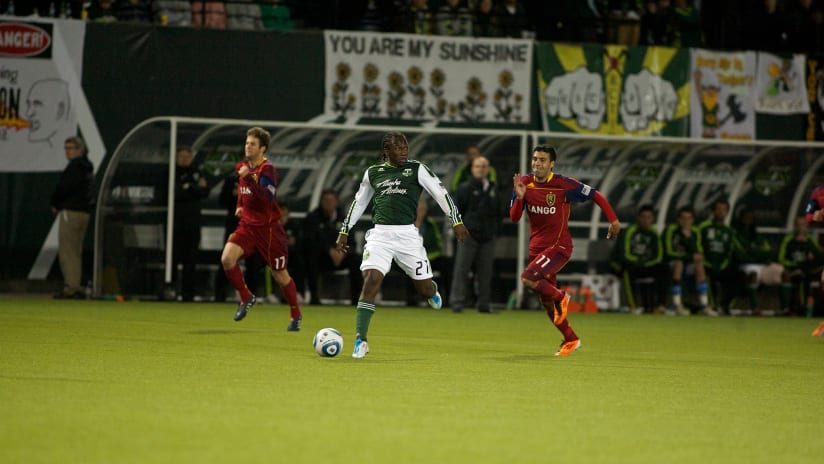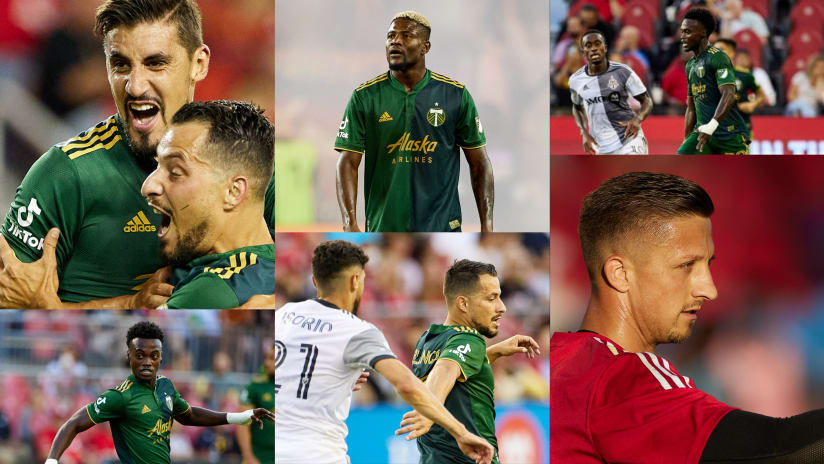Looking back at Diego Chara’s first home game and first start with the Portland Timbers isn’t the time trip you might assume. Of course, there are elements that make April 30, 2011, feel like a bygone era. There's the, um, “relaxed fit” on Real Salt Lake defender Chris Wingert’s jersey …
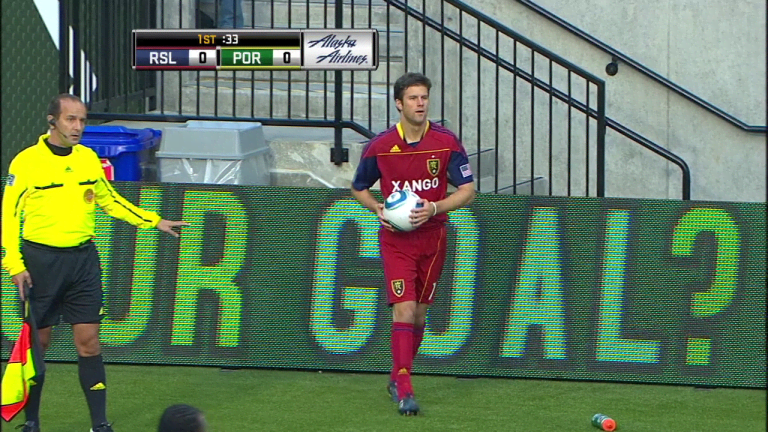
… this sweet camera sans phone being used in the North End …

… and this imposter who forgot the key part of his Nat Borchers cosplay:
In other ways, the match against Real Salt Lake feels more like a parallel universe than an unconnected one. The atmosphere at what’s now Providence Park feels the same. The style of play isn’t so different. Even in John Strong’s call of the game, and the expectations he was setting for the Timbers' future play-by-play voice, Jake Zivin, there was an energy that had a very Timbers feel.
The true legacy of that game, though, was a night of firsts, some more subtle than others. With their 1-0 victory over the Western Conference's standard-bearers, Portland ended one of the longest unbeaten runs in MLS history, handing RSL their first league loss of the season and ending a loss-less stretch that extended back into the 2010 season. The result also marked the home side's first shutout victory in MLS, a much-needed result in the wake of a 3-0 loss at the LA Galaxy one week before.
The day also marked a pair of franchise-changing debuts. For Darlington Nagbe, it wasn’t his first Portland appearance, but thanks to injuries that hindered the start of his professional career, the first draft pick in Timbers history had yet to feature in a starting XI. As another team icon debuted in the middle of the park, the former Akron Zip got his first start on the right side of midfield.
That other team icon is Diego Chara. As with Nagbe, the visit from Real Salt Lake wasn’t his debut. That came the week before when, roughly one day after disembarking a flight from Colombia, the team’s first Designated Player came off the bench at halftime. Seven days later, he went the full 90 minutes, by the end of which the Timbers were averaging only 0.67 goals allowed per 90 minutes with him on the field. It would be 29 days – three games and two more clean sheets – until Portland allowed multiple goals in a game that Chara started.
On that April 30, though, it was still unclear how Chara would fit. In a new team, and playing in an environment that required an adjustment to the surface as well as MLS’ quirks, the then-25-year-old was put in a challenging role. Along with the team’s captain, Jack Jewsbury, he was tasked with holding down a two-man midfield against RSL’s vaunted midfield diamond, and while two of RSL's regular starters, future Timbers Will Johnson and Ned Grabavoy, were rotated out of their XI, future-Hall of Famer Kyle Beckerman was still on the field, as was the league’s precursor to Diego Valeri, Argentine creator Javi Morales. How often through his Timbers career has Chara started in a true two-man midfield, let alone one that had to matchup with a historic RSL setup?
Amid all his adjustments, though, there were still moments that flashed the future Chara: the ball recoveries in the middle; the simplicity of the quick, correct play; the ability to burst forward, past lines of defenders; the propensity for an attack-killing tackle, or a foul that would allow his team a moment to pause. Yes, look closely enough, and the future shined through against RSL, and while his first game in Goose Hollow won’t go down as his most memorable, it did foreshadow the icon Chara would become.
Of course, these were Chara’s first touches
For the first four minutes of Chara’s time in Portland, he was seen but not felt. New stadium, new surface, new teammates: in a game that would produce few chances on goal for either side – where Real Salt Lake was allowed to possess for massive periods of time, albeit at the edges of the Timbers’ defense – the team’s first DP had little to do. Just maintain positioning, make sure the spacing with Captain Jack was right. It was a subdued start.
Then came a play that was too simple to be remarkable, but with nine seasons’ perspective, it looks like vintage Chara.
These are Chara’s first touches as a Timber: gaining possession, playing a simple ball, progressing to a place he can offer another outlet, all in one moment.
There’s an element to that which sounds mundane, and much of the time, it is. The ball he plays back is often referred to as a negative ball because it takes his team backward. At the same time, it’s a good play in the moment. When Chara gains possession, his back is to his attack. It’s a much more efficient play to touch back and claim a new position than turn on the ball. If you go that route, you stop the ball. You let the defense catchup. You potentially cancel out the benefits you gain by turning the opponent over.
Even the pass to his right, after he traps the ball – a hypothetical outside-of-the-foot touch to Kalif Alhassan – isn't so obvious. Look at the options Alhassan would have if the ball went his way. Don’t look long, because there are none. There might be a pass forward to Kenny Cooper, but it’s more likely Jean Alexandre (yes, the Jean Alexandre) closes that lane while Chara’s pass is on the ground.
With players like Chara, Ozzie Alonso, Dax McCarty – the at-times metronomic midfielders who've graced this era of MLS (McCarty is more metronomic than most) – you often think they’re working from sense, or pattern recognition. Something seems to be telling them, “Kalif is open, but you know this midfield is too packed for that to work.” The simple play here gets the ball back to Eric Brunner, who has options at right back (Jeremy Hall), right midfield (Nagbe), the other center back (Futty Danso), potentially the left back (Rodney Wallace) and, in a couple of seconds, a relocated Diego Chara.
This was a theme throughout Chara’s first half. It was well over 30 minutes into the game before he took more than a trap and a touch on the ball. Often, he didn’t even need a second touch. Be it a quick pass or, early on, an errant shot …
… Chara showed his priorities. In a way, he’s a possession player without needing possession, and while that sometimes leads to a healthy criticism of too many sideways or backward balls, those choices are often the right ones. As somebody who’d make his name as a disrupter and ball-winner, Chara's internal thinking seemed to be, ‘I can do more by getting rid of the ball and moving into a new space than trying to claim that space through the dribble.’
The six-versus-eight debate
By the time Chara took his first touch, he’d foreshadowed a debate that lingers to this day. Granted, it’s only hindsight that casts 2011’s movements as evidence of today’s conclusions, but even then – and even when the team switched formations late (from a 4-4-2 to a 4-1-4-1) – curiosity would have made sense: Is Chara better as a deep-sitting midfielder (a six) or a central midfielder (an eight) with more room to roam.
Within the context of 2011’s moment, this question’s pretty ... well, not great. As a midfield pair in a 4-4-2, Chara and Jewsbury had to balance each other. When one moves forward, the other had to stay back. When one went wide, the other had to cover space in the middle. And if either went back into defense to track people toward goal, the other typically had to occupy the space and guard against a pass toward the middle of the field.
That’s just how a midfield usually operates in a 4-4-2, making strict distinctions between a “six” and an “eight” too heavy-handed. Was Chara a six or an eight in his home debut? He was both, as was Jewsbury. They each had to do both jobs.
With today’s biases, though, you can see moments that make you go, “oh, he’s showing he should be a six:"
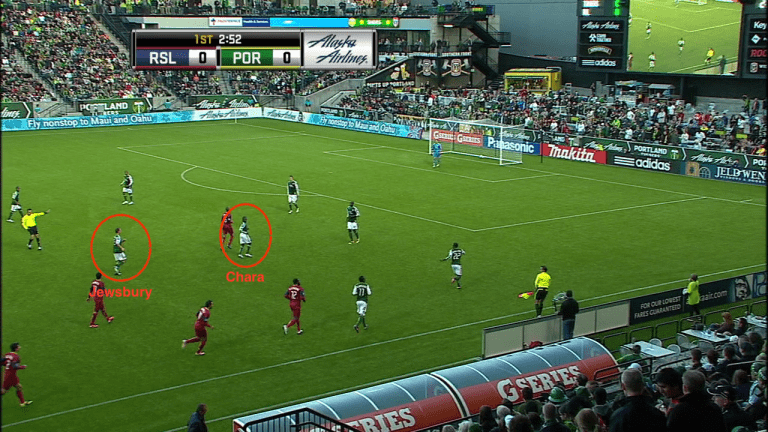
But then fast forward roughly six whole seconds and:
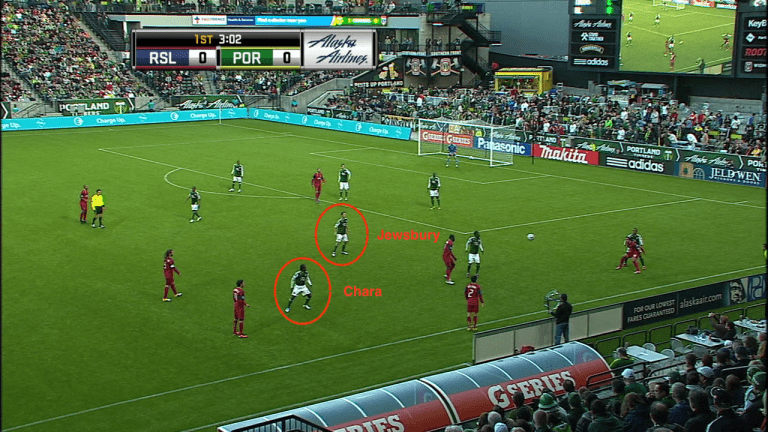
“No, he should be an eight!”
In fairness, nobody looks at one image and says Chara should be anything. At least, almost nobody. Strawman much? Kind of. Consider it a rhetorical device (sorry). This is more about how our relationship with Chara has evolved, and how that evolution can retcon moments like these.
Is he a six? Boom! Look at his first game. Is he an eight? Boom again, though in truth, it doesn’t really matter how one coach used Chara for a few moments eight years ago. What matters are the capabilities he's brought to the field.
The first year I covered Portland for the Timbers, the team had a game at home against FC Dallas, one where Chara started as the left-most midfielder in a 4-3-1-2 formation. By the book (so to speak), that role is usually a more central-playing one than wide, but Chara was still one of the wider players, and therefore subject to a version of the debate: Where is the best place to deploy Diego Chara?
So I talked with the coaching staff in the days after the game. For most of them, it was their first year in Portland, with almost all of Giovanni Savarese’s staff having been assembled in the offseason. But each repeated a logic that some on the previous coaching staff had evoked, as well as some opposing coaches. Why would you want to limit Chara to any single role? Why not use him in a way he’s going to be most effective against that week’s opponent? Against Dallas, there was a specific reason why Chara was the left-most midfielder. He was put in the place where, within Portland’s scheme, his impact could be leveraged most.
I’m a huge fan of the Chara debate, mostly because there is no right answer. In a sense, the only "wrong" view is one without theory – one that hasn't been given enough thought. For over nine seasons, Chara’s forced us to think about where he matters most.
One minute that tells you so much
If the first half showed a Chara adjusting to a new world, the second half showed a wake-up – a shift most evident in this one-minute stretch near the hour mark.
Just before the 60th minute, Chara adjusts after Jewsbury is taken down and forces Beckerman to play one of those negative balls. Chara reacts, bursts from where he was, and keeps a turnover from being a moment of true transition.
Roughly 20 seconds later, after the turnovers leave him shifting between attack and defense, he tracks back to disrupt Morales, helping his teammates recover and force a turnover.
And roughly 40 seconds after that, he notices Morales entering a space vacated by Wallace, who ends up applying pressure to Tony Beltran on the ball. By the time Beltran turns toward the sideline, Wallace has the pass forward covered, but Chara still recognized Morales had moved into an open area. If that ball gets played earlier, somebody has to be there.
None of these plays are remarkable on their own. They’re all nice, possibly even obligatory. That all three happened within 60 seconds, though, showed what Portland could expect from Chara. Midfielder falls? Chara can cover. A player gets between lines? Chara surges back. A runner with space behind a fullback? Chara moves to adjust.
Other players do these things, too. Occasionally, perhaps even frequently, some do. But these are the things Chara’s made his reputation on. They’re the reasons why, from a distance, he’s so easy to overlook. They’re also the reasons why, close up, he’s proven so valuable.
And of course, the trademarks
Lest you think Chara’s story is only in the subtext, there were elements to the main plot. During Chara’s time in Portland, we've seen those elements in the attack-killing challenge …
… the foul that lets his team regroup …
… the sneaky-good passes that get forgotten …
… and the bursts from midfield.
Oh, those bursts from midfield. Even before he touched a ball, Chara provided a hint of those surges, and while nothing came of this moment …
… it does track well with a moment Chara would produce seven years later, also against RSL.
In 2011, it was difficult to see how Chara would evolve, but now, knowing what he’s become within Timbers’ lore, it’s easy to see the signs. The burst that would eventually lead to goals. The tackles that would become more frequent. That tactical knowledge that would go on to buttress an MLS Cup run. They were all there, nine years ago, and in an even more pronounced way, they’re all there, now.

